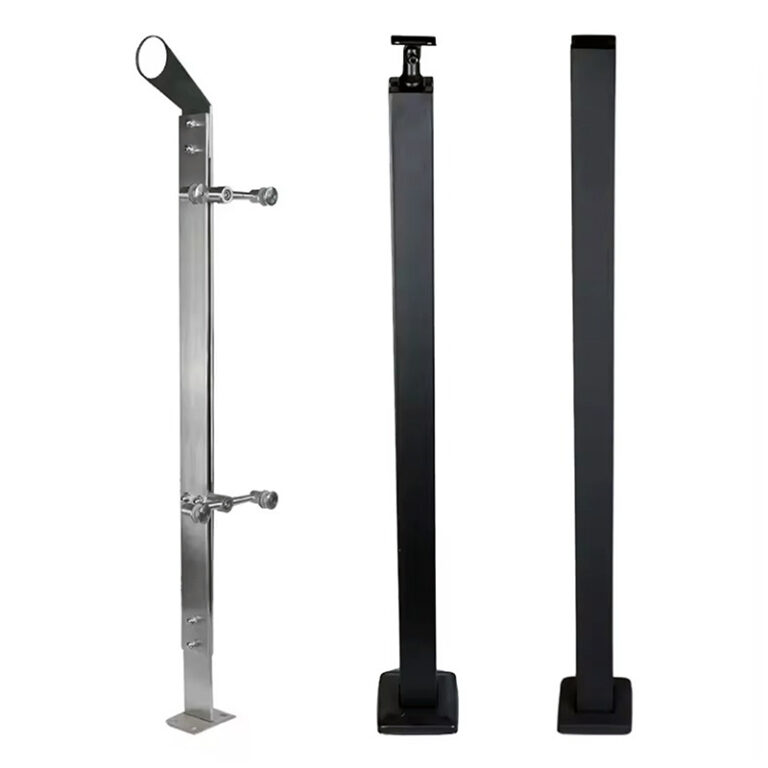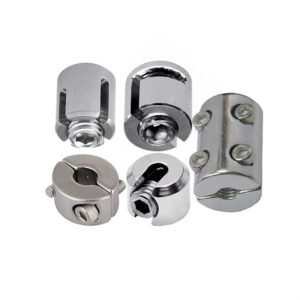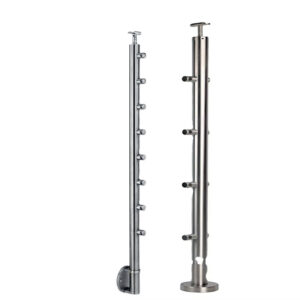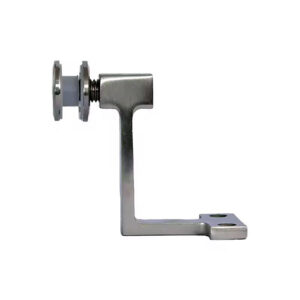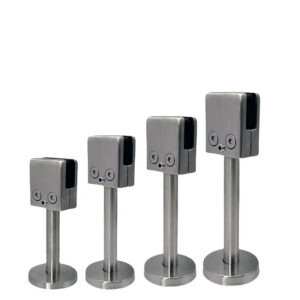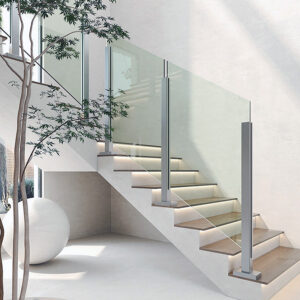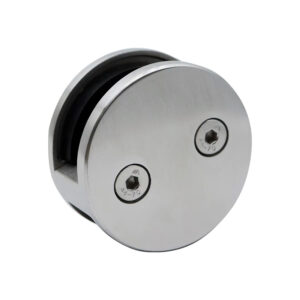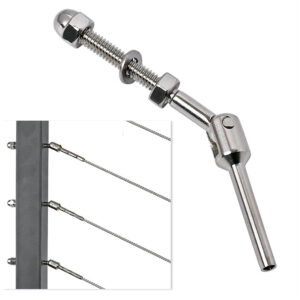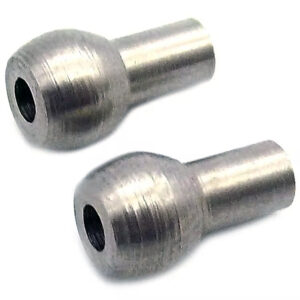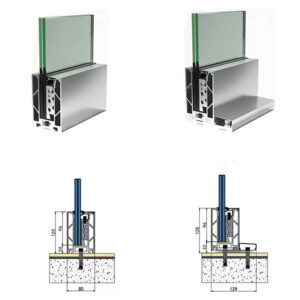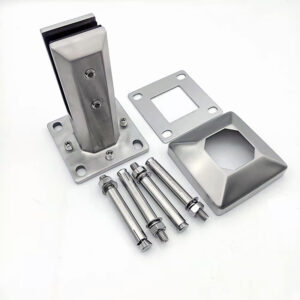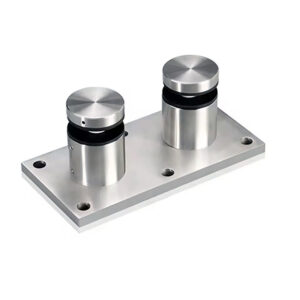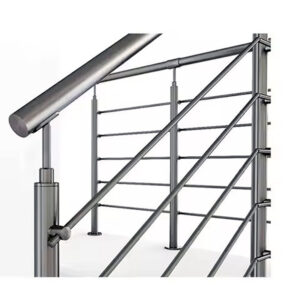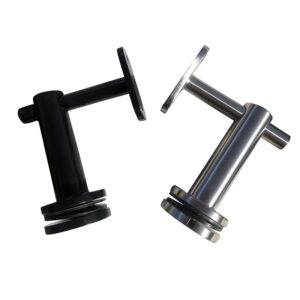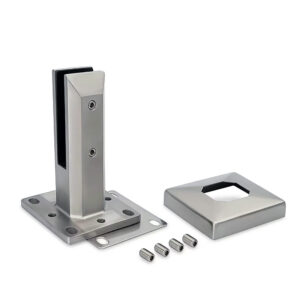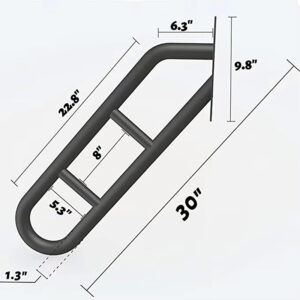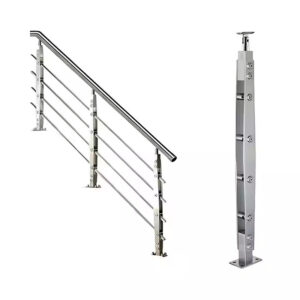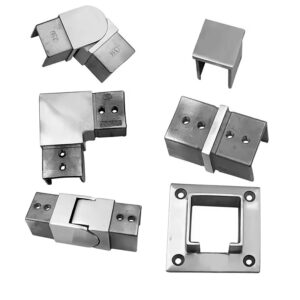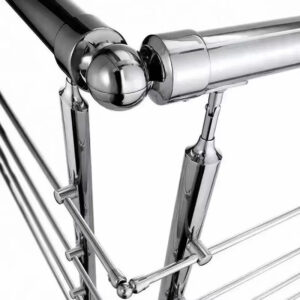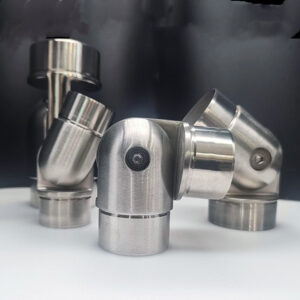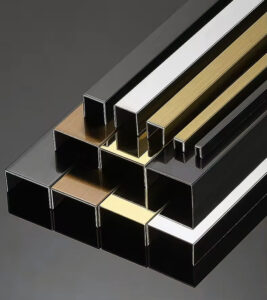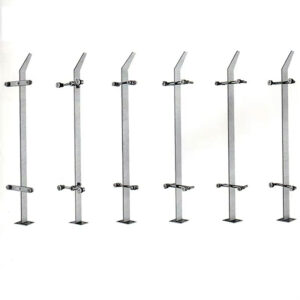Coastal environments destroy standard hardware faster than most contractors expect. Salt air, moisture, temperature swings, and UV exposure create a perfect storm for corrosion and failure. After 23 years manufacturing railing and handrail systems, we’ve learned that coastal projects demand more than upgraded materials—they need engineered solutions that account for every environmental factor. Esang Metal has developed comprehensive coastal installation hardware systems that deliver long-term performance where standard products fail.
Marine-Grade Hardware Systems Built for Coastal Reality
Handrail Systems for Coastal Applications
Our coastal handrail systems use 316L stainless steel as standard, not an upgrade. Wall-mounted, post-mounted, surface-mounted, and continuous rail configurations handle thermal expansion and salt exposure without compromising structural integrity. Each mounting point includes corrosion-resistant gaskets and drainage features that prevent water accumulation—the silent killer of coastal hardware.
Standard handrail profiles accommodate wind loads up to 50 psf while maintaining code compliance across most coastal jurisdictions. Pre-engineered brackets reduce field fabrication time by 60% compared to custom solutions, crucial when weather windows limit installation schedules.
Railing Posts and Structural Components
Coastal railing posts require oversized wall thickness to handle both structural loads and long-term corrosion resistance. Our 316L marine grade coastal components include round and square posts from 2″ to 6″ diameter, with wall thickness starting at 0.125″ minimum. Post caps incorporate positive drainage to prevent standing water—a common failure point in marine environments.
Surface-mounted posts use through-bolt systems with marine sealants rated for 20+ year service life. Core mounting hardware includes stainless fasteners with anti-galling coatings and neoprene washers that maintain compression through thermal cycling.
▶ Get Coastal Hardware Specs ◀
Glass Railing Hardware for Coastal Installations
Glass railing systems in coastal locations face unique challenges: salt buildup affects glass clarity while hardware must accommodate structural movement from wind and thermal stress. Our coastal glass hardware uses 316L construction throughout: base shoes, glass clamps, standoffs, and structural glazing supports.
Drainage channels in base shoes prevent salt water accumulation that causes glass stress cracking. Adjustable glass clamps accommodate 1/2″ to 3/4″ tempered glass with gasket systems designed for UV and salt resistance. Wind load calculations include coastal exposure factors often missed in standard installations.
Cable Railing Systems for Marine Environments
Cable railing represents the most challenging coastal application due to cable tension requirements and hardware accessibility for maintenance. Our commercial coastal hardware systems use 1/8″ or 3/16″ marine-grade 316L cable with swage fittings rated 2x working load limits.
Through-post cable systems eliminate intermediate hardware exposed to salt spray. End terminations include accessible tensioning with corrosion-resistant threads and weather seals. Cable spacing meets IBC 4″ sphere rule while accounting for thermal sag in high-temperature coastal environments.
Custom Coastal Hardware Manufacturing
Twenty-three years of coastal project experience taught us that standard solutions often need modification for site-specific conditions. Our ODM coastal installation manufacturing capabilities include custom post heights, specialized mounting configurations, and integrated drainage solutions.
Recent custom projects included hurricane-rated handrails for Gulf Coast commercial buildings, seawall-mounted systems with adjustable heights for tidal variations, and modular railing systems for coastal boardwalks requiring seasonal removal. Each solution maintains structural integrity while addressing unique environmental factors.
Technical Specifications for Coastal Performance
| Material Grade | Chloride Resistance | Typical Applications | Service Life |
|---|---|---|---|
| 304 Stainless | Limited coastal use | Protected areas only | 5-10 years |
| 316 Stainless | Good marine resistance | General coastal construction | 15-25 years |
| 316L Marine | Superior coastal performance | Direct salt exposure | 25+ years |
| Duplex 2205 | Extreme environment | Industrial marine | 30+ years |
| Load Capacity | Wind Rating | Thermal Movement | Installation Time |
|---|---|---|---|
| 200 lbs concentrated | 50 psf wind load | ±1/2″ per 100 ft | 40% faster than custom |
| 50 lbs/ft distributed | 85 mph wind speed | Expansion joints included | Pre-fab components |
| Seismic Zone D rated | Hurricane tie-downs | Flexible connections | Standard tool installation |
▶ Discuss Your Coastal Project ◀
Coastal Project Applications and Results
Residential Coastal Properties
Multi-unit coastal housing projects require balancing cost control with long-term durability. A recent South Carolina oceanfront development used our modular coastal systems across 240 units: balcony railings, stair handrails, and walkway systems. Standardized components reduced installation time 45% while 316L construction eliminated the maintenance reserves typically required for coastal properties.
Project results after three hurricane seasons: zero hardware failures, minimal maintenance requirements, and insurance premium reductions due to proven wind resistance performance. Total cost of ownership dropped 30% compared to painted steel alternatives when factoring replacement and maintenance cycles.
Commercial Coastal Construction
A Virginia Beach hotel renovation required ADA-compliant handrails throughout exterior walkways and pool areas. Direct salt spray exposure and high usage demanded both durability and consistent appearance. Our commercial coastal hardware systems provided integrated LED lighting channels, slip-resistant grip surfaces, and modular sections for efficient replacement.
Installation during tourist season required night work with strict noise limitations. Pre-fabricated sections with plug-together connections enabled complete installation in 12-hour shifts. After five years of service, annual maintenance consists only of pressure washing—no refinishing, repair, or component replacement required.
Industrial Marine Applications
Port facility railing systems face the harshest conditions: constant salt spray, chemical exposure, impact from cargo handling, and 24/7 operation requirements. A recent Gulf Coast terminal project required 2,000 linear feet of heavy-duty railings meeting both OSHA and Coast Guard standards.
Our marine grade coastal components included 4″ diameter posts on 6-foot spacing, continuous top rails with integrated cable management, and removable sections for equipment access. Galvanic isolation prevented corrosion between dissimilar metals in the existing structure. Three-year performance review showed zero corrosion, maintained structural ratings, and reduced maintenance costs 70% versus previous carbon steel systems.
Coastal Infrastructure Projects
Municipal boardwalks and pier applications require public safety compliance, weather resistance, and long-term budget predictability. A recent Florida pier reconstruction used our modular coastal systems for 1,500 feet of pedestrian railings with integrated benches and lighting.
Hurricane preparation includes rapid removal capability—entire sections disconnect and store in 30 minutes. Post-storm reinstallation uses the same connection points with no special tools. After two major hurricane seasons, total damage consisted of three bent intermediate rails—easily replaced without affecting structural components.
▶ Review Coastal Case Studies ◀
Installation Support and Technical Resources
Engineered Installation Systems
Coastal installations face tight weather windows and challenging access conditions. Our modular approach reduces field work through pre-assembled sections, standardized connections, and detailed installation sequences. Complete installation packages include layout drawings, fastener schedules, and step-by-step procedures.
Wind and weather protocols provide safe installation guidelines for coastal conditions. Temporary bracing systems maintain safety during multi-day installations when weather delays occur. All hardware includes installation torque specifications and joint sealant requirements for long-term performance.
Quality Control for Coastal Applications
Manufacturing precision becomes critical in coastal environments where field adjustments are difficult and expensive. Our quality control process includes dimensional verification, surface finish consistency, and fastener compatibility testing. Each shipment includes material certifications and installation hardware inventories.
Pre-delivery inspection catches tolerance issues that cause installation delays. Assembly instructions include coastal-specific details: sealant application, drainage orientation, and thermal expansion accommodation. Technical support during installation prevents common mistakes that compromise long-term performance.
Long-Term Support and Maintenance
Twenty-three years of coastal project experience provides realistic maintenance expectations and schedules. Most installations require only annual pressure washing and periodic gasket inspection. Replacement parts availability extends system life beyond typical project planning horizons.
Maintenance training programs help facility managers understand coastal-specific requirements. Preventive maintenance schedules account for varying exposure levels within the same project. Technical support includes performance troubleshooting and upgrade recommendations as codes and standards evolve.
▶ Talk to Our Coastal Engineers ◀
Frequently Asked Questions
How do I choose the right stainless grade for coastal exposure?
Material selection depends on distance from water, prevailing wind direction, and budget constraints. Within 1000 feet of breaking waves, 316L provides the best cost-performance balance. Protected areas beyond 1/2 mile may allow 316 standard grade. Industrial coastal environments often require duplex grades for chemical resistance. Our material selection guide includes site assessment criteria and long-term cost comparisons.
What’s the real installation time difference with modular systems?
Documented time savings average 40-45% versus custom fabrication, but coastal projects see higher benefits due to limited weather windows. Pre-fabricated sections install in predictable timeframes regardless of field conditions. A typical 100-foot residential balcony railing installs in 6-8 hours versus 2-3 days for field-fabricated systems. Commercial projects with repetitive sections show even greater time savings.
How do you handle thermal expansion in long coastal installations?
Thermal movement in coastal environments combines temperature swings with solar heating on exposed surfaces. Expansion joints occur every 40-60 feet depending on orientation and local climate data. Sliding connections allow movement while maintaining structural continuity. Post mounting includes oversized holes with flexible gaskets. Our thermal analysis includes site-specific calculations for expansion joint placement.
What maintenance should I expect with marine-grade hardware?
Properly specified 316L systems in direct coastal exposure typically require annual pressure washing and five-year gasket inspection. Moving components like gates or adjustable sections need annual lubrication with marine-grade products. Hardware in protected locations often extends maintenance intervals to 3-5 years. We provide site-specific maintenance schedules based on exposure assessment and local environmental factors.
Can existing posts support upgraded coastal hardware?
Existing post evaluation includes material compatibility, structural capacity, and mounting condition assessment. Galvanic isolation prevents corrosion between dissimilar metals. Structural analysis determines if existing foundations handle increased wind loads from code updates. Many upgrades work with existing posts through adapter hardware and reinforcement techniques. Site evaluation includes connection details and upgrade feasibility.
How do you ensure code compliance across different coastal jurisdictions?
Coastal jurisdictions often have additional requirements beyond standard building codes: hurricane provisions, flood zone considerations, and corrosion protection standards. Our engineering team maintains current requirements for major coastal markets. Standard products include design margins that accommodate most local variations. Custom engineering addresses unique jurisdictional requirements while maintaining cost-effective solutions.
▶ Connect with Our Coastal Team ◀
Performance Comparison and Selection Guide
| Solution Type | Initial Cost | Installation Time | 10-Year Maintenance | Total Cost of Ownership |
|---|---|---|---|---|
| Painted Steel | Low | Standard | High (refinishing/replacement) | High |
| Aluminum | Medium | Fast | Medium (refinishing) | Medium |
| 304 Stainless | Medium-High | Fast | Low (protected areas) | Medium-Low |
| 316L Marine Grade | High | Fast | Very Low | Low |
Selection criteria depend on project requirements, environmental exposure, and long-term ownership plans. Painted steel requires 3-5 year refinishing cycles in coastal environments, often exceeding initial hardware cost. Aluminum provides good corrosion resistance but limited structural capacity for high-load applications.
Our 316L marine grade systems deliver the lowest total cost of ownership through extended service life and minimal maintenance requirements. Performance data from 23 years of coastal installations provides realistic cost projections and maintenance expectations. Project-specific analysis includes local environmental factors, usage patterns, and ownership planning horizons.
“Marine-grade railing systems typically reduce 20-year lifecycle costs by 40-60% compared to conventional alternatives in coastal applications.” —Coastal Construction Research Institute
“Standardized coastal hardware systems cut project timelines and reduce weather-related installation delays significantly.” —Marine Construction Association
“Proper material selection and installation details determine long-term success more than initial cost considerations in coastal environments.” —National Association of Marine Contractors
Coastal installation hardware requires balancing immediate project needs with long-term performance expectations. Our comprehensive approach addresses material selection, installation efficiency, and lifecycle cost optimization through proven engineering solutions and manufacturing experience. Contact our technical team to discuss your specific coastal project requirements and develop cost-effective solutions that deliver reliable long-term performance.
